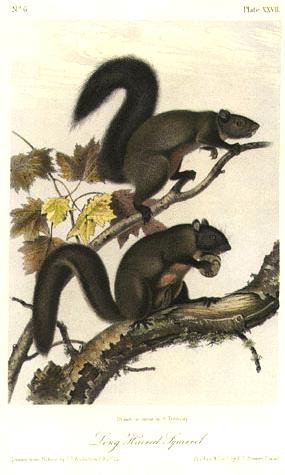

27 Long Haired Squirrel
SCIURUS LANIGERUS.--AUD. AND BACH.
[Sciurus griseas]
WOOLLY SQUIRREL.
[Western Gray Squirrel]
PLATE XXVII.
Sc. migratorii magnitudine; pilis longis et lanosis; cauda ampla, villosa
vixque disticha; naso, auriculis, pedibusque pene nigris; vellere supra ex
cinereo fusco; subtus dilute fusco.
CHARACTERS.
Size of Sciurus migratorius; hair, long and woolly; tail, large and bushy;
nose, ears, and feet, nearly black; upper surface, grizzly dark gray and brown;
under parts, pale brown.
SYNONYME.
SCIURUS LANIGERUS, Aud. and Bach., Journal of the Acad. Nat. Sc., Philad.,
1841, p. 100
DESCRIPTION.
Head, short; forehead, arched, nose, blunt; clothed with soft hair;
whiskers, longer than the head; eyes, large; ears, large, broad at base, ovate.
Body, stout, covered with long and woolly hairs, which are much longer and
a little coarser than those of the Northern gray squirrel.
Legs, stout; feet, of moderate size; claws, strong, compressed, arched and
sharp. The third toe, longest; a blunt nail in place of a thumb. Palms, naked;
toes, hairy to the extremity of the nails.
Tail, long and bushy, and the hairs long and coarse.
COLOUR.
Incisors, dark orange on the outer surface; the head, both on the upper and
lower surface, as far as the neck, the ears, whiskers, fore-legs to the
shoulder, feet, and inner surface of hind-legs, black; with a few
yellowish-brown hairs intermixed. The long fur on the back is for half its
length from the roots, light plumbeous, then has a line of light-brown, and is
tipped with reddish-brown and black.
The hairs on the tail, in which the annulations are very obscure, are for
one-third of their length brownish-black, then light-brown, then brownish-black,
and are tipped with ashy-white. On the under surface the hairs, which are
short, are at the base light-plumbeous, tipped with light-brown and black; the
throat is light grayish-brown.
Of two specimens received from the same locality, the head of one is
lighter-coloured than that of the other, having a shade of yellowish-brown; in
other respects they are precisely similar; a figure of each is given on the
plate.
DIMENSIONS.
Inches.
Length of head and body . . . . . . . . . . 11 7/8
Tail (vertebrae) . . . . . . . . . . . . 10
Tail, to end of fur . . . . . . . . . . . 12
Height of ear posteriorly . . . . . . . . . 0 3/4
Breadth of ear . . . . . . . . . . . . . 0 3/4
From heel to end of middle claw. . . . . . . . 2 1/2
Hairs on the back . . . . . . . . . . . . 1 1/8
HABITS.
We have been unable to obtain any information in regard to the habits of
this species. Its form, however, indicates that it is a climber, like all the
species of the genus, living in forests, feeding on nuts and seeds. Its long
woolly coat proves its adaptation to cold regions.
GEOGRAPHICAL DISTRIBUTION.
Our specimens were procured from the northern and mountainous portions of
California.
GENERAL REMARKS.
The difficulty in finding characters by which the various species of this
genus can be distinguished, is very great. There is, however, no variety of any
other species of squirrel that can be compared with that here described. Its
black head and legs, brown back and belly, its broad ears and long woolly hair,
are markings by which it may be easily distinguished from all others.
|